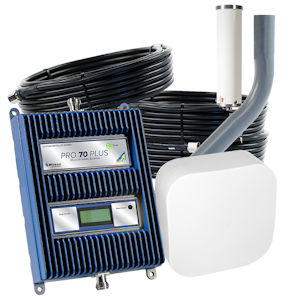What are the differences between the WilsonPro 1100 and WilsonPro 70 Plus?
Updated
WilsonPro is Wilson Electronics’s commercial cellular amplifier brand. The WilsonPro line of cell signal amplifiers includes solutions for all coverage needs, from SOHO (small office/home office) up to commercial and public buildings of 100,000 square feet or more.
In this review, we’ll compare the WilsonPro 1100 (460147, 461147) with the WilsonPro 70 Plus (463127, 460127, 460227).
The WilsonPro 1100 and Pro 70 Plus were both discontinued in .
Wilson Electronics introduced the WilsonPro 70 Plus in ; at that time, it was their most powerful commercial solution for in-building cell signal problems. In 2019 Wilson took a dramatic leap forward with the debut of the WilsonPro 1100, which has more power and more features than the WilsonPro 70 Plus.
Where they’re the same
Some features are identical in the WilsonPro 70 Plus and the WilsonPro 1100. These include:
- Cellular frequencies supported:
- 700 MHz (SMH bands 12, 17, 13)
- 850 MHz (CLR band 5)
- 1700/2100 MHz (AWS band 4)
- 1900 MHz (PCS bands 2, 25)
- Max uplink gain: 70 dB
- Gain control: Automatic (AGC)
- Amplifier design: Metal housing
- Impedance: Choice of 50 ohm or 75 ohm
- Connectors: Choice of N connectors (50 Ω) or F connectors (75 Ω)
- Cables: Choice of 400-type coax (50 Ω) or RG11 coax (75 Ω)
- Manufacturer’s warranty: 3 years
- Certifications: FCC and carrier preapproval (no operating license required)
The WilsonPro 1100 and the WilsonPro 70 Plus are both capable amplifiers that work on the major frequencies that will continue to be the backbone of cellular service for many years to come. They both operate at the maximum possible gain permitted by the FCC and are available in the two popular impedance/connector/cable types used by installers of commercial cellular amplifiers.
Where they differ
Actual max uplink gain
While the WilsonPro 1100 and WilsonPro 70 Plus are both advertised as 70 dB boosters, actual test figures show that the WilsonPro 1100 has considerably higher gain thresholds—in other words, it comes closer to the FCC’s 72 dB gain limit before automatic gain control (AGC) kicks in.
These maximum uplink gain figures are from test reports submitted by Wilson Electronics to the FCC:
As the data indicate, the WilsonPro 1100 has 2 to 3 times the maximum uplink gain of the WilsonPro 70 Plus in lower-frequency cellular bands, and 12 to 15 times the max uplink gain in higher frequency bands. This gives the WilsonPro 1100 a substantial performance edge over the WilsonPro 70 Plus.
Maximum power output
- Uplink power is the amount of output power (measured in decibel-milliwatts or dBm) the booster uses to communicate with the cell tower’s antenna. The more uplink power, the farther the booster can reach to distant towers.
- Downlink power is the amount of power the booster uses to reach cellular phones and devices inside the building. The more downlink power, the larger the area of indoor coverage and the greater the booster’s ability to penetrate walls and floors to reach phones.
These figures are from specifications published in Wilson’s user manuals:
The WilsonPro 1100 has considerable advantages over the WilsonPro 70 Plus in both uplink and downlink power. This means that the WilsonPro 1100 will perform better in weak outside signal environments by being able to communicate with more distant towers, and it will provide stronger inside signal and larger coverage area in most outside coverage situations.
Dimensions & weight
- WilsonPro 70 Plus: 6″ ᴡ × 8.75″ ʜ × 1.5″ ᴅ × 2.8 lbs.
- WilsonPro 1100: 9″ ᴡ × 10″ ʜ × 2″ ᴅ × 6.3 lbs.
The WilsonPro 1100 is 50% wider and 14% taller than the WilsonPro 70 Plus, and it weighs over twice as much as the earlier unit. With the increased size and weight comes increased performance, but you will need a larger area on your wall to mount it.
XDR technology
- WilsonPro 70 Plus: No overload protection
- WilsonPro 1100: XDR overload prevention
Many commercial cell signal amplifiers operate in situations where outside cellular signal is strong but unable to penetrate the building’s concrete or metal walls and low-e glass. When outside signal is too strong, the WilsonPro 70 Plus shuts off any frequencies that are overloaded. In those situations, professional installers are forced to use attenuators that reduce the signal received by the amplifier across all bands, even if the problem is only a specific band that’s too strong.
The WilsonPro 1100 incorporates Wilson Electronics’s patented XDR (eXtended Dynamic Range) technology that prevents signal overload and amplifier shut down. When the WilsonPro 1100 detects that any band of incoming signal is too strong, XDR automatically reduces the amplifier’s gain to maintain the strongest possible signal coverage throughout the building.
Open space indoor coverage
- WilsonPro 70 Plus: Up to 20,000 ft² with one antenna
- WilsonPro 1100: Up to 30,000 ft² with one antenna
With its higher maximum uplink gain, increased uplink and downlink power output, and XDR overload protection, the WilsonPro 1100 has a considerable coverage advantage over the WilsonPro 70 Plus. Because of this, the WilsonPro 1100 has become Wilson Electronics’s “go to” signal amplifier for commercial and public buildings of all sizes and even for large homes that need coverage for multiple cellular networks.
Need help choosing the best WilsonPro system?
The experts at Powerful Signal have been improving cellular reception in buildings of all sizes since 2007. Please call us at 435-634-6800 or contact us online—we’ll be happy to help you find the best system to improve cellular reception in your office or home.




